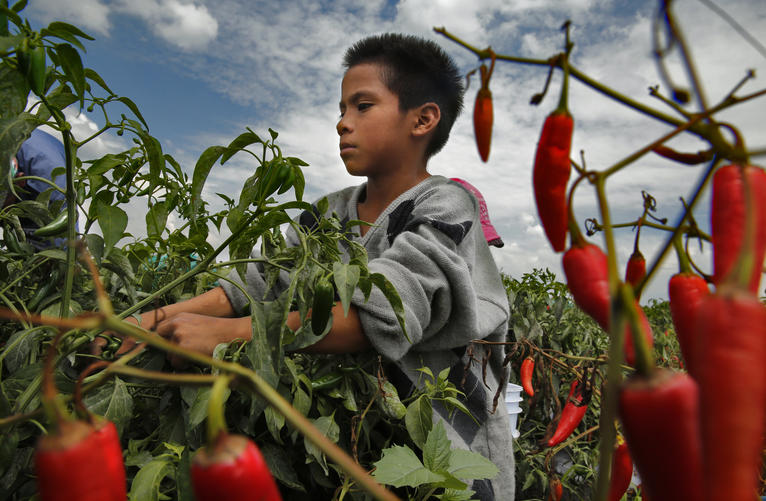
Click to enlarge — LA Times/Don Bartletti
Half the tomatoes consumed in the U.S. come from Mexico
The tomatoes, peppers and cucumbers arrive year-round by the ton, with peel-off stickers proclaiming “Product of Mexico.”
Farm exports to the U.S. from Mexico have tripled to $7.6 billion in the last decade, enriching agribusinesses, distributors and retailers.
American consumers get all the salsa, squash and melons they can eat at affordable prices. And top U.S. brands — Wal-Mart, Whole Foods, Subway and Safeway, among many others — profit from produce they have come to depend on.
These corporations say their Mexican suppliers have committed to decent treatment and living conditions for workers.
But a Los Angeles Times investigation found that for thousands of farm laborers south of the border, the export boom is a story of exploitation and extreme hardship.
Many farm laborers are essentially trapped for months at a time in rat-infested camps, often without beds and sometimes without functioning toilets or a reliable water supply.
Some camp bosses illegally withhold wages to prevent workers from leaving during peak harvest periods.
Laborers often go deep in debt paying inflated prices for necessities at company stores. Some are reduced to scavenging for food when their credit is cut off. It’s common for laborers to head home penniless at the end of a harvest.
Those who seek to escape their debts and miserable living conditions have to contend with guards, barbed-wire fences and sometimes threats of violence from camp supervisors.
Major U.S. companies have done little to enforce social responsibility guidelines that call for basic worker protections such as clean housing and fair pay practices.
The farm laborers are mostly indigenous people from Mexico’s poorest regions. Bused hundreds of miles to vast agricultural complexes, they work six days a week for the equivalent of $8 to $12 a day.
The squalid camps where they live, sometimes sleeping on scraps of cardboard on concrete floors, are operated by the same agribusinesses that employ advanced growing techniques and sanitary measures in their fields and greenhouses.
The contrast between the treatment of produce and of people is stark.

One of ~100,000 Mexican children under 14 who pick crops…He is 9 years old.
The comparison with Edward R Murrow’s “Harvest of Shame” about migrant labor on US farms in 1960 is appropriate. Some of the poor buggers in that documentary probably were the fathers and mothers, grandfathers and grandmothers of folks revealed in this series of articles.
This is the kind of long-form journalism still popular outside the United States. Sometimes, I feel our Establishment deliberately encourages Americans to develop the attention span of a cricket. It would be an injustice for me to use my usual editor’s X-Acto knife on the wealth of information inside these articles. Richard Marosi and Don Bartletti are to be congratulated much for their work undercover – and cold-call walk-ins. I hope the journalism craft recognizes their work appropriately.
Please, please, RTFA. There’s a link above to this the first in the series.
Here are the links to:
Part 2: A raid exposes brutal conditions at Bioparques, one of Mexico’s biggest tomato exporters, which was a Wal-Mart supplier. But the effort to hold the grower accountable is looking more like a tale of impunity.
Part 3: The company store is supposed to be a lifeline for migrant farm laborers. But inflated prices drive people deep into debt. Many go home penniless, obliged to work off their debts at the next harvest.
Part 4: About 100,000 children under 14 pick crops for pay at small- and mid-size farms across Mexico, where child labor is illegal. Some of the produce they harvest reaches American consumers, helping to power an export boom.
Thanks, Mike
Kudos for finding us one of the best pieces of American journalism in quite a while









